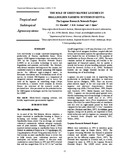| dc.contributor.author | Mureithi, J G | |
| dc.contributor.author | Gachene, C K K | |
| dc.contributor.author | Ojiem, J | |
| dc.date.accessioned | 2013-05-29T09:00:10Z | |
| dc.date.available | 2013-05-29T09:00:10Z | |
| dc.date.issued | 2003 | |
| dc.identifier.citation | Tropical and Subtropical Agroecosystems 1( 2003): 57-70 | en |
| dc.identifier.uri | http://erepository.uonbi.ac.ke:8080/xmlui/handle/123456789/26897 | |
| dc.description | Journal article | en |
| dc.description.abstract | Low soil fertility is a major constraint hampering the
productivity of Kenyan smallholder farms. Green
manure (GM) legume technologies were introduced in
1994 by the Legume Research Network Project
(LRNP) as an accessible technology to arrest soil
degradation and maintain soil fertility. The Network,
with diverse members working across the country, has
conducted research to identify promising GM legume
species for different agro-ecological zones, to
determine inoculation and P fertilization needs of the
species, to evaluate GM legumes as a component of
integrated nutrient management, and to assess the
value of the legumes in controlling striga (Striga
hermonthica), a noxious weed common in western
Kenya. An overview of the research results is
presented here. Also presented are the potential niches
for GM legume technologies and the way forward for
the LRNP. | en |
| dc.language.iso | en | en |
| dc.subject | Maize-based cropping systems | en |
| dc.subject | Soil fertility improvement | en |
| dc.subject | Green manure legumes. | en |
| dc.title | The role of gren manure legumes in smallholder farming systems in Kenya: the legume research network project | en |
| dc.type | Article | en |
| local.publisher | Department of soil science, University of Nairobi | en |

